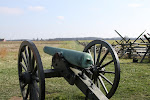So sorry I have not kept this blog up. It's not that I haven't been writing. I've written plenty and most of it can be found at the news site lincolnparishjournal.com. But I will begin posting many of those articles here.
At lunch last week, three men I know well sat nearby discussing a new book about the death of outlaws Clyde Barrow and Bonnie Parker—a book I had just read. Although about a dozen previous books address the ambush that relieved mid-America of these killers, “The Trap” aims to tell the true story of their demise.
Two of the three men had personal connections to the story, being related to Prentiss Oakley, a Bienville Parish deputy sheriff who was part of the ambush party. While their interest in the new book comes in part from the familial connection, there’s thousands of other Americans who research and study the Barrow gang and even worship them.
Imagine, adoring two people linked to the murders of 13 men, 12 of them law enforcement officers.
My own interest comes from the couple’s connection to Ruston history and my law enforcement background. About a year before the ambush, Barrow and Parker and Clyde’s brother Buck and Buck’s wife Blanche kidnapped two Ruston residents.
In American crime lore, few duos evoke the same blend of romanticism, rebellion, and tragedy as Barrow and Parker. Ambushed and killed on a rural Bienville Parish road in 1934, they were just 25 and 23 years old. Nearly a century later, their names remain etched in American memory—not merely as criminals, but as cultural icons. What is it about these Great Depression Era outlaws that continues to captivate the public imagination?
Barrow and Parker came of age in a country ravaged by economic collapse, creating widespread hardship. For some, like young Barrow, crime offered a twisted kind of opportunity. Barrow’s descent into criminal life began with petty theft and escalated into robbery and murder, forming the core of what came to be known as the Barrow Gang.
Parker, a petite waitress and aspiring poet, joined him in what many have viewed as an unlikely love story forged in blood and desperation. Their romantic partnership has become a cornerstone of the legend, often overshadowing the stark violence of their crimes.
The press played a significant role in mythologizing the couple. Sensational headlines painted them as modern-day Robin Hoods, romantic renegades robbing rich bankers to survive the privations of the day. Newspapers ran glamorized photos of Bonnie with a cigar in her mouth and a pistol in hand—imagery that added to the mythos.
“Bonnie and Clyde were media darlings of their time,” says historian Jeff Guinn, author of Go Down Together: The True, Untold Story of Bonnie and Clyde,” one of the better books on the couple. That image was carefully cultivated, not just by the press, but in some cases, by Bonnie and Clyde themselves.”
America has long held a fascination with outlaws—from Jesse James to John Dillinger—and Bonnie and Clyde fit the mold of the antihero perfectly. They were young, good-looking, and seemingly bound to one another. Their defiance of authority during a time of widespread economic hardship tapped into a deep undercurrent of public frustration.
The blurred line between lawlessness and justice is a recurring theme in storytelling. Popular films like Bonnie and Clyde (1967), starring Warren Beatty and Faye Dunaway, amplified the legend. The film’s sympathetic portrayal became a cultural milestone and earned two Academy Awards. It was a product of its era, released amid Vietnam protests and civil unrest.
But Bonnie and Clyde and those who ran with them on occasion were not the Robin Hood-like heroes as some movies portray them. They robbed few banks but focused on mom and pop stores that couldn’t afford to lose even a day’s receipts. Any money they gave away went to family members back in Dallas.
There is no denying the emotional pull of a doomed romance, and Bonnie and Clyde’s relationship remains a key element in their appeal. From handwritten poetry Bonnie composed while on the run to the couple’s dramatic death, their story carries a Shakespearean quality. “Some day they’ll go down together / they’ll bury them side by side,” she wrote.
They did go down together but are buried in separate Texas cemeteries..
This blending of crime and love has given their story a staying power few criminals ever achieve. Their legacy is not just that of bloodshed and robbery, but of intimacy forged in chaos. In a time dominated by disconnection and digital relationships, theirs offers a paradoxically raw and tangible intensity.
Today, remnants of their journey draw thousands of tourists and enthusiasts. The ambush site near Gibsland, marked by a modest marker that endures constant vandalism and theft, remains a pilgrimage for devotees and the curious. A Nevada casino houses the bullet-riddled Ford V8 in which they died. Memorabilia, biographies, and podcasts continue to unpack their crimes and mythologies. Even decades later, artists and writers mine their legacy for new interpretations.
Incredibly, the two have their defenders. Society drove them to do what they did, some say. Forget that most Americans survived the Great Depression without committing crimes. True sycophants will fight you if you accuse Bonnie Parker of ever killing anyone. She just rode along with the man she loved.
Despite—or perhaps because of—the violence they inflicted, Bonnie and Clyde endure as cultural figures that evoke undeserved empathy and awe. They were neither heroes nor martyrs, but something more complex—human beings caught in a fierce storm of love, lawlessness, and legend.















No comments:
Post a Comment